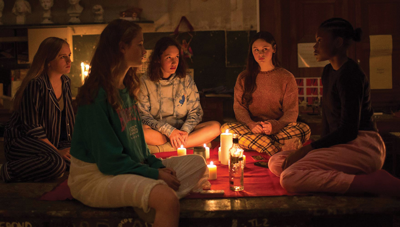
Mélissa is a survivor. As played by Wislanda Louimat, she keeps her emotional cards close to her chest — a survivor of the earthquake that devastated Haiti in 2010, she now lives with her Aunt Katy in France, attending a prestigious school that she, despite having earned her way in, flits along the periphery of. Until, that is, she catches the eye of Fanny (Louise Labèque), who invites her to join the unofficial sorority she has established with some other young women. They get together in the middle of the night. They drink. They read and write stories. And perhaps they open forbidden doors in the process?
The young women, legacies of the French Légion d’Honneur, have gathered at this school to learn from the best. The path of their future is to become 21st-century women, helping to shape the world around them and guide it back from the precipice of annihilation. And their vibrant hearts, alive with hormones and knowledge and the operatic uncertainty of being young at this moment in history, compel them into some interesting places.
Mélissa’s grandfather was a man named Clairvius Narcisse, you see. Narcisse was a real person who lived in Haiti, and tales of his alleged early-’60s zombification persist to this day. He was, as the story goes, turned into a shambling half-alive slave and put to work in the fields of sugarcane plantations. But he escaped. He managed to unscramble his mind and regain some semblance of a normal life, even going on to have children. But when you’ve been taken beyond the barrier that exists between life and death, what exactly remains? The 1962 portions of the film are keyed into a very specific color palette, using the kind of low-light latitude that digital cinematography excels at (see also: the forthcoming Vitalina Varela, which finds the soul in every pixel), mixed with day-for-night tactics more than a century old. At times, it feels like a completely new way of seeing, being tied to Narcisse’s zombification in such a fashion that we feel this violation of human consciousness as an insult to the way the brain processes everything around us.
At no point does writer-director Bertrand Bonello spell out the anti-colonial narratives at play here, but the observant viewer is keyed in from the beginning. The narrative of worker exploitation has been taken by Western culture and used for its own ends, whether as a critique of consumerist society (Romero) or as an aggressive means of dehumanizing the other to pave the way for reactionary libertarianism and fascism (The Walking Dead). Here, on a small scale, we are made to confront the ways in which global monoculture devours and rearranges everything it touches. The story of Clairvius Narcisse is utterly fascinating, and the fact that the film aims to set the record of his life straight while still exploring the textural hothouse of the modern zombie narrative is a remarkable feat.
The film addresses phenomena we’re not used to seeing addressed at the movies. What is the last film you can think of that acknowledges how white youth blossoms with the approval and respect of black eyes, even if it is only grudgingly offered? This film understands that Mélissa gets pushed out of her own story by the uncomprehending need evinced by her friends. Rather than learning from the history of horrors visited upon Haiti by colonialism (acts that still occur to this day on a global scale), Kreyol magick is seen as something that can be manipulated and tapped into to help in the uncertain hearts of teenagers in love. And as is always the case, when white people in the grip of their emotions start dipping their toes into cultural phenomena they don’t understand, crazy shit happens.
There may not be a more densely politically and culturally charged moment in any film this year than when the young women of the society are gathered in secret, chanting the lyrics of controversial French rapper Damso’s “N. J Respect R” as if the words were a spell being cast across the land. You have to go back to the 1999 masterpiece Black and White by perennial alleged sexual harasser James Toback to find a film that is this interested in how privileged white children extract strength and power from the culture and history of black lives. And you’d be hard-pressed to find a film anything like Zombi Child — it is a singular experience, equal parts exorcism, tone poem, teen drama and cautionary sensual riot. Like all truly enduring films about teenage lives, every hairstyle tells a story — even in scenes in which silent extras dominate the frame, there are stories being told.
Bonello has made some of the greatest films of the past decade: 2011’s House of Tolerance is the closest any filmmaker has come to the immersive, sensual, dollhouse magnificence of Hou Hsiao-Hsien’s Flowers of Shanghai, but with the added bonus of deconstructing The Moody Blues’ “Nights in White Satin” as an anthem for the spirit of humanity (see also Barbara Albert’s Böse Zellen); 2016’s Nocturama is an insightful, wrenching gaze into the heart of disaffected youth and the allure of radical action (in its way, a sibling to Guadagnino’s Suspiria); and with 2014’s Saint Laurent, he made not only one of the greatest biopics of all time, but also one of the greatest gay films of all time, and one of the best films about fashion. So it is not an exaggeration to proclaim Bonello one of the best directors working today. Zombi Child finds him working at a more heightened and ambitious level, and it is a bold and bludgeoning masterpiece.





